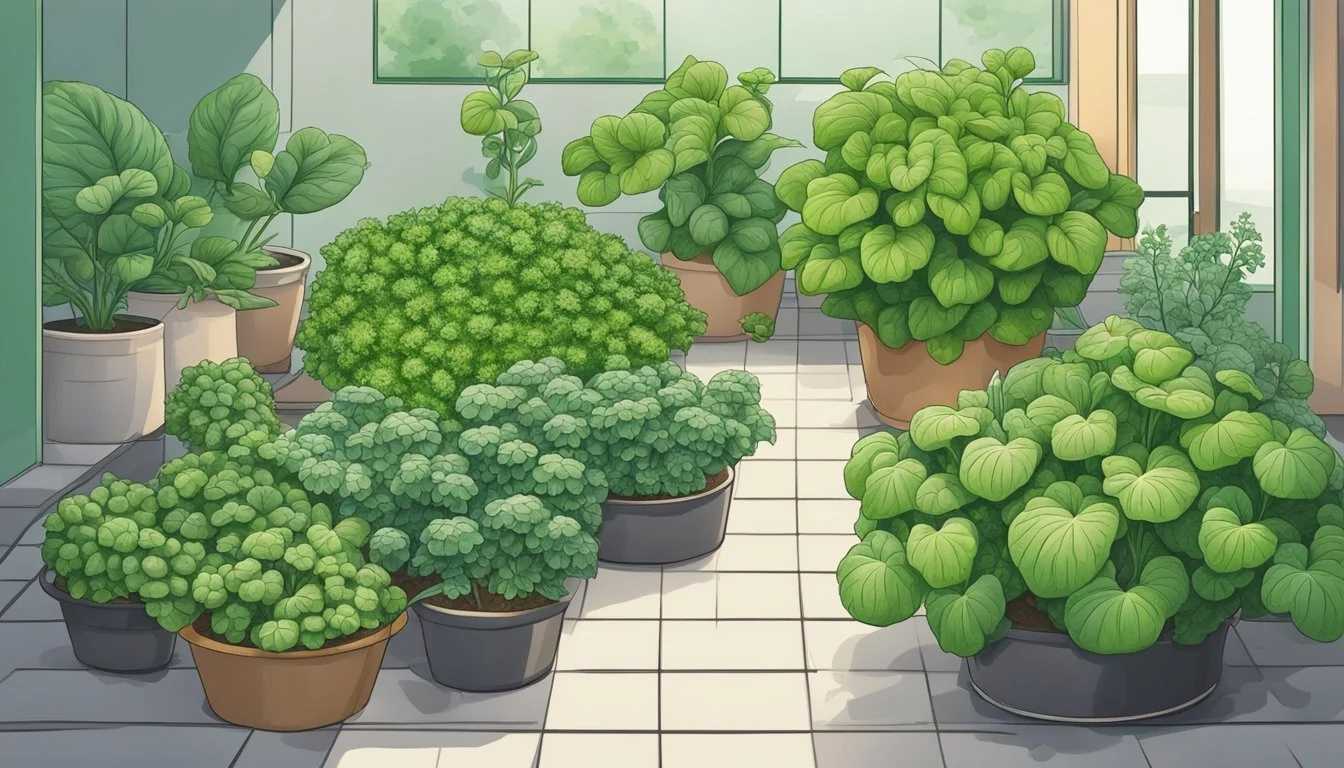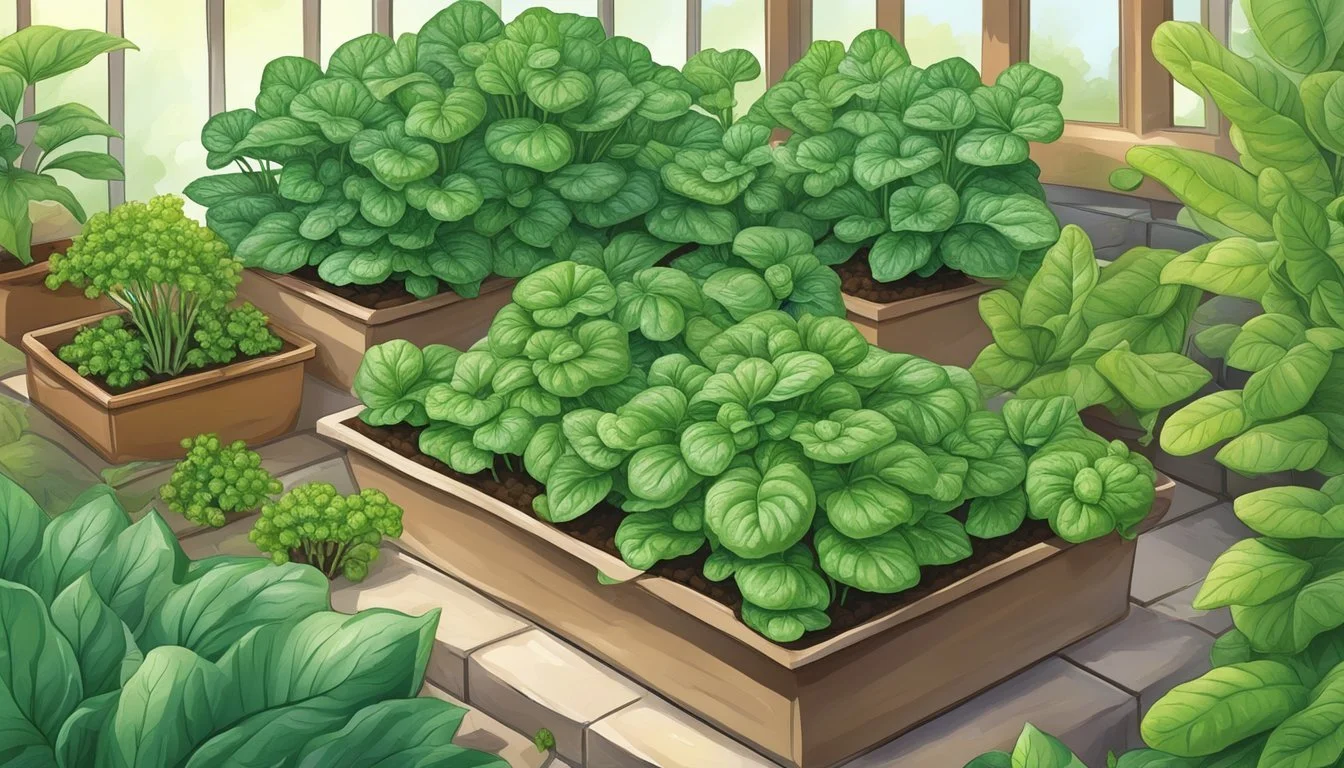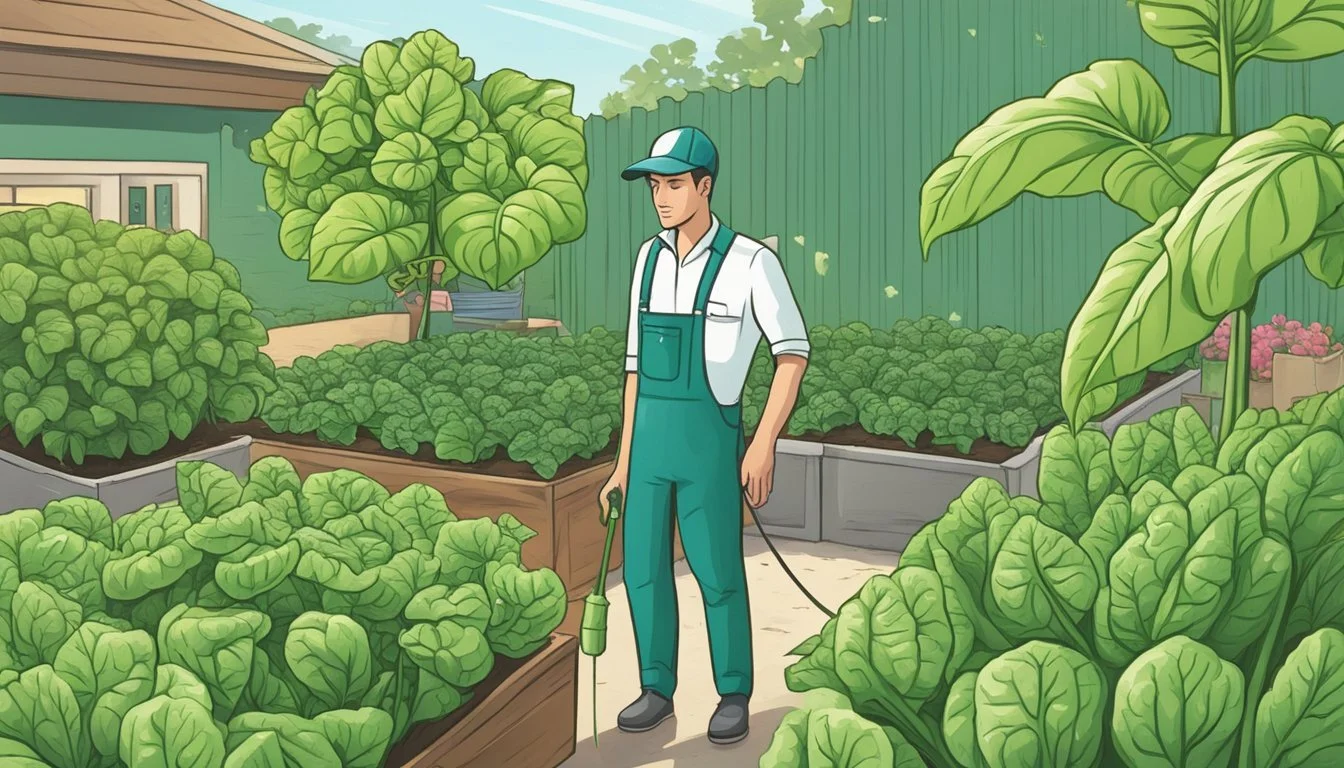Pest Control for Tatsoi
Effective Strategies for Healthy Greens
Tatsoi, a spoon-shaped Asian green, is a versatile and nutritious leafy vegetable that has become a favorite among gardeners for its ease of growth and rich flavor. However, like many plants, it can be susceptible to a range of pests that can damage or even destroy the crop. Effective pest control is crucial to ensure that these greens reach their full potential, both in the garden and on the table.
Gardeners aiming to cultivate healthy tatsoi plants must be vigilant in monitoring for signs of infestation. Common tatsoi pests include slugs, which can be managed through methods such as trap crops or a beer trap, and cabbage worms, which can be controlled by natural predators or by maintaining proper garden hygiene. Another challenge is the bacterial pest Phoma lingam, which can cause lesions on roots and stems, necessitating good management practices such as crop rotation and use of underground irrigation to prevent spread.
Understanding the life cycle of these pests and implementing preventive measures can significantly reduce the likelihood of severe infestations. Some approaches include fostering beneficial insect populations, using barriers to physically protect the plants, and applying organic pest control methods when necessary. By taking these steps, gardeners can enjoy a bountiful harvest of tatsoi, free from the detriments of common garden pests.
Understanding Tatsoi
Tatsoi, a resilient leafy green, thrives in various growing conditions and is lauded for its versatility and nutritional value.
Origins and Characteristics
Tatsoi, originating from Asia, is a variety of Brassica rapa often referred to as spoon mustard due to its spoon-shaped, dark green leaves. This cool-season crop is known for its ability to withstand colder temperatures, which makes it a popular choice for early spring and late fall plantings. Its rosette-forming habit allows it to grow low to the ground, and when mature, it makes a stunning visual addition to garden beds.
Nutritional Profile
The nutritional profile of Tatsoi is impressive, as it offers a rich source of vitamins and minerals with particular abundance in vitamins A, C, and calcium. The dark green leaves indicate a high level of carotenoids and other nutrients, contributing to a balanced diet. Consuming Tatsoi can be beneficial for maintaining good health due to its nutrient-dense nature.
Preparing the Garden for Tatsoi
When planning to grow tatsoi, one must focus on selecting the appropriate soil as it is crucial for optimal plant health and yield. Understanding the climate and sun exposure requirements will further ensure that tatsoi thrives in the garden setting. Finally, precise sowing techniques are paramount to facilitate successful germination and plant development.
Selecting the Right Soil
Soil Type: Tatsoi plants flourish in sandy or loamy soils that provide good drainage. The ideal soil structure should allow water to penetrate and reach plant roots while avoiding water-logging, which could damage the plant.
Soil pH: Aim for a soil pH between 6.0 and 7.5, ideal for tatsoi growth, with a sweet spot around 6.5 to 7.0. If necessary, perform a soil pH test to determine adjustments to the soil acidity or alkalinity. A well-balanced pH facilitates nutrient uptake and healthy plant growth.
Ideal Climate and Sun Exposure
Tatsoi is a cool-season crop and thrives in conditions that provide it with a combination of cool temperatures and adequate sunlight.
Climate: They are best planted in early spring or autumn to avoid the heat of summer.
Sun Exposure: Though tatsoi can tolerate partial shade, they grow optimally in a garden that receives full to partial sunlight. Ensuring proper light is essential for strong plant structure and leaf development.
Sowing Tatsoi Seeds
To ensure effective germination, follow these specific steps:
Spacing: Disperse tatsoi seeds over the prepared garden soil and lightly cover them—no need for deep planting.
Germination: Keep the soil consistently moist as tatsoi seeds require adequate moisture to germinate properly. Tatsoi seedlings typically emerge within 7-12 days, depending on the surrounding conditions.
By diligently preparing the garden for tatsoi, gardeners can create an environment where this leafy green can grow to its full potential, providing a nutritious and delicious harvest.
Tatsoi Plant Care
Proper care ensures healthy growth and productivity of tatsoi plants. They require consistent moisture, specific nutritional inputs, and protection against diseases that can affect their yield and quality.
Watering and Nutrition
Tatsoi thrives in soil that remains evenly moist. They require about 1 inch of water each week, whether through rainfall or irrigation. To maintain this level, gardeners may opt for drip irrigation techniques which provide steady moisture while minimizing leaf wetness and disease risks. Nutritionally, tatsoi benefits from nitrogen-rich fertilizers—organic options like well-composted manure can be applied to prepare the soil before planting. Periodic using liquid fertilizers can support leafy growth, especially during the peak growing season.
Spacing and Thinning
Proper spacing is critical to prevent overcrowding and promote air circulation. When sowing tatsoi seeds, aim to thin the young plants to at least 6 inches apart once they reach 2 to 4 inches tall. This spacing allows each plant ample room to grow, which reduces the incidence of fungal diseases like downy and powdery mildew.
Preventing Diseases
To safeguard tatsoi from diseases, crop rotation and good airflow are essential practices. Applications of organic pesticides or fungicides may be necessary to prevent or manage outbreaks of common diseases, such as black lesions caused by bacterial pests. Raised beds and proper irrigation techniques, which avoid water splashing onto the foliage, can also significantly reduce the risk of diseases. Maintaining optimal pH levels in the soil, between 6.0 and 7.5, can further contribute to the health of tatsoi plants.
Pest Management in Tatsoi Cultivation
Effective pest management in tatsoi cultivation is crucial for maintaining a healthy crop. Recognizing common pests and applying appropriate control methods are key aspects to ensure the quality and yield of tatsoi greens.
Identifying Common Pests
Tatsoi can be affected by a variety of insect pests, such as flea beetles, aphids, caterpillars, moths, slugs, and cabbage worms. Flea beetles create small holes in the foliage, while aphids, which are often found in clusters, can cause leaves to curl and wilt. Caterpillars and moths chew through leaves, leaving large irregular holes behind. Slugs are nocturnal pests that leave a slimy trail on the plants and devour young leaves and stems.
Natural Pest Control Methods
Employing natural pest control methods is often preferred to keep tatsoi healthy and safe for consumption. Neem oil is an organic option effective against a wide range of pests. Regular applications can deter infestations. Beneficial insects such as ladybugs can control aphids naturally. Incorporating crop rotation into the planting schedule prevents the build-up of soil-borne pests and diseases. Additionally, diatomaceous earth can be sprinkled around the base of plants to manage slugs and other crawling pests.
Chemical Control Options
When natural methods are insufficient, chemical control may be necessary. Products containing spinosad or pyrethrins are available for use against many tatsoi pests. These insecticides target the nervous system of insects, providing effective control. Care should be taken to follow label instructions to minimize impact on the environment and non-target organisms, such as birds and beneficial insects. Chemical use should be the last resort, after all other methods are considered.
Harvesting and Storing Tatsoi
Proper timing and handling are essential for ensuring the quality of tatsoi from harvest to storage. As a tender leafy green, tatsoi can be harvested at various stages of growth to be used in salads and a variety of culinary applications.
Best Time to Harvest
Tatsoi is a versatile plant that can be harvested in spring, late summer, and fall, with the leaves being most tender during the cooler parts of its growing season. Young leaves can be harvested as early as 20 to 25 days for dwarf varieties, while full-size leaves typically take 40 to 50 days. The best time for harvesting is early morning when the leaves are crisp, and it's ideal to harvest tatsoi when they reach about 4 inches in length.
Post-Harvest Handling
Once harvested, it is important to handle tatsoi gently to prevent bruising. Rinse the leaves in cool water to remove any soil or pests, then pat dry carefully. It is recommended to harvest only what will be consumed in the short term, as tatsoi is most flavorful and nutrient-rich when fresh.
Storage Tips
For storing tatsoi, wrap the leaves in a damp paper towel and place them in a plastic bag, keeping a bit of air inside. Refrigeration can help tatsoi stay fresh, but it is best used within a few days to maintain its quality. Avoiding excess moisture is key to prevent wilting and spoilage. Longer storage times may require blanching and freezing for future use.
Incorporating Tatsoi Into Your Diet
Tatsoi, an Asian green hailing from the regions of Japan and China, is recognizably marked by its spoon-shaped, dark green leaves. The plant forms a neat rosette that can be a vibrant addition to any dish, thanks to its mild mustard flavor. Incorporating tatsoi into one's diet offers both culinary diversity and health benefits.
Ways to Enjoy Tatsoi:
Raw in Salads: Its tender leaves make tatsoi an excellent base for salads. Simply wash the leaves and mix them with other salad greens to introduce a new flavor and texture to your dish.
Cooked Dishes: Whether stir-fried, sautéed, or steamed, tatsoi wilts nicely and can complement a variety of Asian-inspired recipes. Its robust nature stands up well to heat, maintaining a pleasant crunch.
Serving Suggestions:
Add raw tatsoi leaves to a sandwich for a nutritious crunch.
Toss tatsoi into a hot soup just before serving; it will wilt similarly to spinach, adding a nutrient-packed punch.
Stir-fry tatsoi with a medley of other vegetables and a protein of choice for a quick and easy meal.
Nutritional Highlights:
Tatsoi is more than just a culinary delight. It is loaded with essential nutrients that support overall health. These nutrients include:
Vitamins: Rich in vitamins A, C, and K.
Minerals: Contains minerals such as calcium and iron.
In conclusion, tatsoi can enrich a diet with both its unique flavor profile and its notable health benefits. Whether one is looking to add a new type of green to their salad repertoire or seeking a versatile ingredient for cooked dishes, tatsoi is an excellent choice. Its ease of preparation and compatibility with various culinary styles make it a must-try for anyone interested in exploring the rich tapestry of Asian greens.
Eco-Friendly Gardening Practices
Eco-friendly gardening practices for tatsoi not only enhance crop health and yield but also contribute to sustainable agriculture. The focus lies on nurturing the soil, conserving water, and fostering a balanced ecosystem.
Composting and Organic Fertilizers
Composting is a cornerstone of eco-friendly gardening, transforming kitchen scraps and yard waste into nutrient-rich soil that sustains healthy tatsoi plants. Incorporating organic fertilizers such as composted manure or commercially available organic blends, which release nutrients slowly, is crucial for robust growth without the environmental impact of synthetic options.
Compost: Incorporates beneficial microorganisms and nutrients
Manure: Provides nitrogen, phosphorus, and potassium
Straw: Mulch to prevent weed growth and retain soil moisture
Lime: Balances soil pH for optimal nutrient uptake
Water Conservation Methods
Efficient water conservation is essential in an eco-friendly garden. Smart irrigation systems and practices like drip irrigation or soaker hoses target water directly to tatsoi's roots, minimizing waste. Additionally, mulching with organic materials conserves moisture and regulates soil temperature, reducing the frequency of watering.
Irrigation: Employ drip lines for targeted watering
Mulching: Use straw or leaf mulch to retain water
Promoting Biodiversity
Biodiversity is fundamental to an eco-friendly garden. Diverse plantings attract beneficial insects that serve as natural pest control for tatsoi. Regular crop rotation prevents soil depletion and disrupts pest cycles. Encouraging air circulation between plants minimizes fungal issues, and planting a variety of species ensures a resilient garden ecosystem.
Beneficial Insects: Encourage ladybugs and lacewings
Crop Rotation: Switch plant families annually
Air Circulation: Space tatsoi adequately to prevent disease
Tatsoi Culinary Uses
Tatsoi, also known as spoon mustard or spinach mustard, is a versatile Asian green celebrated for its use in a variety of culinary applications. This leafy vegetable forms a rosette shape with small, spoon-shaped leaves that are mild in flavor and tender in texture, making them perfect for both raw and cooked dishes.
Salads: Fresh tatsoi leaves enrich salads with their subtle and pleasant taste. They can easily replace or complement greens like spinach, kale, or bok choy.
Sautéing and Stir-Fries: In Asian cuisines, tatsoi is a common addition to stir-fries. To retain its delicate texture, it’s recommended to add tatsoi towards the end of cooking.
Cool Weather Crops: As a cool weather crop, tatsoi thrives in both full sun and partial sun conditions. Its ability to withstand cold temperatures makes it a robust choice for gardeners.
Ideal Cooking Methods and Pairings:
Raw: Incorporate into salads or use as a garnish.
Steamed/Sautéed: Combine with garlic and a touch of oil for a simple side dish.
Stir-Fried: Add to Asian-inspired recipes with ingredients like soy sauce and sesame oil.
Storage and Preparation:
Store: Keep tatsoi in a dry and cool place to maintain its freshness.
Prepare: Wash leaves thoroughly before use.
Tatsoi's compatibility with other Asian greens and its robust nature that allows it to grow in less than ideal conditions, such as cooler climates, makes it a must-try for those exploring culinary uses of diverse vegetables. Whether used raw in a crunchy salad or gently wilted in a warm stir-fry, tatsoi is a nutritious and flavorful addition to many dishes.
Advanced Tips for Growing Tatsoi
Growing tatsoi successfully requires an understanding of its ideal conditions and how to maintain plant health throughout the growing season. Here are some advanced insights for cultivating this leafy green.
Ideal pH Levels and Adjustments
For tatsoi to thrive, maintaining the soil pH within the range of 6.0 to 7.5 is crucial. Test your soil and, if necessary, make adjustments. Add lime to raise the pH level if it's too acidic, or use sulfur to lower it if it’s too alkaline. Tatsoi, being a member of the brassica family, fares best in slightly acidic to neutral loamy soil, which provides it with the rich nutrients it desires.
Optimizing Plant Health
To encourage optimal growth, ensure that your tatsoi is planted in well-drained soil enriched with organic matter. Adequate spacing, between 6 to 8 inches, allows for sufficient airflow, reducing the risk of fungal diseases. Regular watering that achieves a depth of 1 inch per week can help maintain the necessary humidity levels without over-saturating the soil. Pest control is paramount as tatsoi can attract common offenders within the brassica family; natural deterrents or insect netting can be effective measures.
Seasonal Considerations
Tatsoi can be planted in both the early spring and fall. It prefers cool weather and can even withstand light frosts, making it a resilient choice for your vegetable garden. Ideal temperatures for tatsoi range from 50 to 75°F (10 to 24°C). Heat can cause tatsoi to bolt, thereby ending the growing season prematurely. Therefore, if an unexpected warm spell occurs, providing shade can help mitigate temperature spikes.
Troubleshooting Common Issues
When cultivating Tatsoi, gardeners often encounter challenges such as unexpected pests, soil inconsistencies, and issues with watering. A clear understanding of these problems and decisive action can ensure the healthy growth of your plants.
Handling Unexpected Pests
Insects such as cabbage worms, aphids, and flea beetles are common pests that attack Tatsoi. To manage these pests, one can use row covers to deter them or apply organic pesticides. For example, neem oil is effective against aphids and can help in maintaining an insect-free garden. Additionally, identifying and picking off cabbage worms by hand can also be an efficient way to protect your plants.
Slugs are particularly attracted to the tender leaves of Tatsoi. Creating physical barriers or setting up slug traps can reduce their presence. Integrating natural predators, such as birds or beneficial insects, into your garden ecosystem is another sustainable strategy to keep slug populations under control.
Dealing With Soil Problems
Proper soil management is vital for healthy Tatsoi plants. For optimum growth, Tatsoi requires well-drained soil rich in organic matter. To improve drainage and soil structure, incorporate compost or aged manure into your soil. In cases where mildew is a concern, ensuring the soil is not overly compacted and has adequate aeration can help prevent its occurrence.
Regular soil testing can help in identifying nutrient deficiencies, and appropriate fertilization can address these shortages. Balanced nutrition is critical in developing strong plants that are less susceptible to diseases and pests.
Addressing Watering Concerns
Watering plays a crucial role in the cultivation of Tatsoi. The plant thrives in consistently moist soil, but overwatering can lead to root issues and increase the risk of disease. Achieving the right balance is essential; Tatsoi typically requires about an inch of water per week, whether through rainfall or manual watering.
When watering, aim to keep the foliage dry to reduce the risk of fungal diseases. Drip irrigation or soaker hoses can be particularly effective in delivering water directly to the roots while keeping leaves dry. Additionally, maintaining proper humidity levels and mulching can help retain soil moisture and regulate soil temperature, creating a conducive environment for Tatsoi growth.
Enhancing Your Tatsoi Experience
To truly savor the cultivation of tatsoi, one must consider the diversity of varieties within the Brassica family, adopt innovative gardening techniques, and tap into the wisdom of the gardening community. This holistic approach not only fortifies against pests but also maximizes the pleasure and yield of growing this Asian green.
Exploring Different Tatsoi Varieties
Tatsoi, a member of the Brassica rapa species, offers several distinct varieties that can bring diversity to one's vegetable garden. The spoon-shaped leaves are characteristic of the species, but they come in several forms. Varieties such as Tatsoi Green Coin and Tatsoi Rosette provide subtle differences in flavor and texture. Some may favor the robust taste of traditional tatsoi, while others might prefer the milder Mizuna, a close relative that falls under the same species but with fringed leaves.
Creative Gardening Techniques
To nurture a successful tatsoi crop, it's essential to apply strategic gardening techniques. Companion planting is one approach—growing tatsoi alongside other members of the brassica family like bok choi or bok choy can help deter pests through diversity. Further tailoring of the garden might include elevated beds or container gardening, which can help manage slug populations commonly found preying on tatsoi. Additionally, the use of natural mulches can enhance soil health and moisture retention, providing an ideal environment for tatsoi to thrive.
Engaging Community and Resources
The experience of growing tatsoi is greatly enriched by engaging with the wider gardening community. One can seek out local gardening clubs or online forums for tips, especially when dealing with pests or trying new varieties. Community resources, such as workshops or local extension services, can provide valuable insights into organic pest control methods. Sharing experiences and challenges with fellow growers can lead to discovering new strategies and cultivating a sense of camaraderie within the vegetable gardening community.
By embracing variety, innovative tactics, and community wisdom, the cultivation of tatsoi can be a delightful and rewarding endeavor.
Frequently Asked Questions
In addressing tatsoi pest control, it's crucial to focus on prevention and the use of natural methods to maintain a healthy crop. Identification of the pests and targeted actions can significantly manage the pest population.
How do I deal with insects eating my tatsoi leaves?
If insects are eating tatsoi leaves, one can manually remove pests as a first step. For larger infestations, organic insecticidal soaps can be effective while being safe for the plant and environment.
Can you suggest natural methods for controlling pests in tatsoi plants?
Yes, natural methods such as introducing beneficial insects like ladybugs or using companion planting techniques to deter pests can help protect tatsoi plants. Additionally, applying neem oil can be a suitable organic option for pest control.
What are the common pests found in tatsoi, and how can I prevent them?
Common pests include aphids, flea beetles, and slugs. Preventative measures such as using floating row covers and maintaining clean garden practices reduce the likelihood of these pests establishing themselves in tatsoi crops.
How do I protect my tatsoi crops from mustard green pests?
Mustard green pests, like cabbage loopers or diamondback moths, pose a threat to tatsoi. Cultural controls and regular monitoring are first steps in protection. If necessary, organic Bacillus thuringiensis (Bt) can be applied to specifically target these caterpillars.
Are there any organic pest control solutions effective against mustard bugs on tatsoi?
Organic pest control solutions like horticultural oils and insecticidal soaps can be effective against mustard bugs. Preventing infestation by rotating crops and maintaining healthy soil also contribute to keeping tatsoi plants free from these pests.
What should I do to manage Brassica pest issues on my tatsoi?
For Brassica pests like aphids and flea beetles on tatsoi, one should encourage natural predators and use organic sprays. Regular inspections for signs of pests will also aid in early detection and management.












